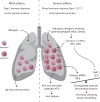Neutrophilic Inflammation in Asthma and Association with Disease Severity
- PMID: 28784414
- PMCID: PMC5711587
- DOI: 10.1016/j.it.2017.07.003
Neutrophilic Inflammation in Asthma and Association with Disease Severity
Abstract
Asthma is a chronic inflammatory disorder of the airways. While the local infiltration of eosinophils and mast cells, and their role in the disease have long been recognized, neutrophil infiltration has also been assessed in many clinical studies. In these studies, airway neutrophilia was associated with asthma severity. Importantly, neutrophilia also correlates with asthma that is refractory to corticosteroids, the mainstay of asthma treatment. However, it is now increasingly recognized that neutrophils are a heterogeneous population, and a more precise phenotyping of these cells may help delineate different subtypes of asthma. Here, we review current knowledge of the role of neutrophils in asthma and highlight future avenues of research in this field.
Copyright © 2017 Elsevier Ltd. All rights reserved.
Figures

References
-
- Sur S, et al. Sudden-onset fatal asthma. A distinct entity with few eosinophils and relatively more neutrophils in the airway submucosa? Am Rev Respir Dis. 1993;148(3):713–9. - PubMed
-
- Gibson PG, et al. Heterogeneity of airway inflammation in persistent asthma : evidence of neutrophilic inflammation and increased sputum interleukin-8. Chest. 2001;119(5):1329–36. - PubMed
-
- Wenzel SE, et al. Evidence that severe asthma can be divided pathologically into two inflammatory subtypes with distinct physiologic and clinical characteristics. Am J Respir Crit Care Med. 1999;160(3):1001–8. - PubMed
-
- Jatakanon A, et al. Neutrophilic inflammation in severe persistent asthma. Am J Respir Crit Care Med. 1999;160(5 Pt 1):1532–9. - PubMed
-
- Norzila MZ, et al. Interleukin-8 secretion and neutrophil recruitment accompanies induced sputum eosinophil activation in children with acute asthma. Am J Respir Crit Care Med. 2000;161(3 Pt 1):769–74. - PubMed
Publication types
MeSH terms
Substances
Grants and funding
LinkOut - more resources
Full Text Sources
Other Literature Sources
Medical

